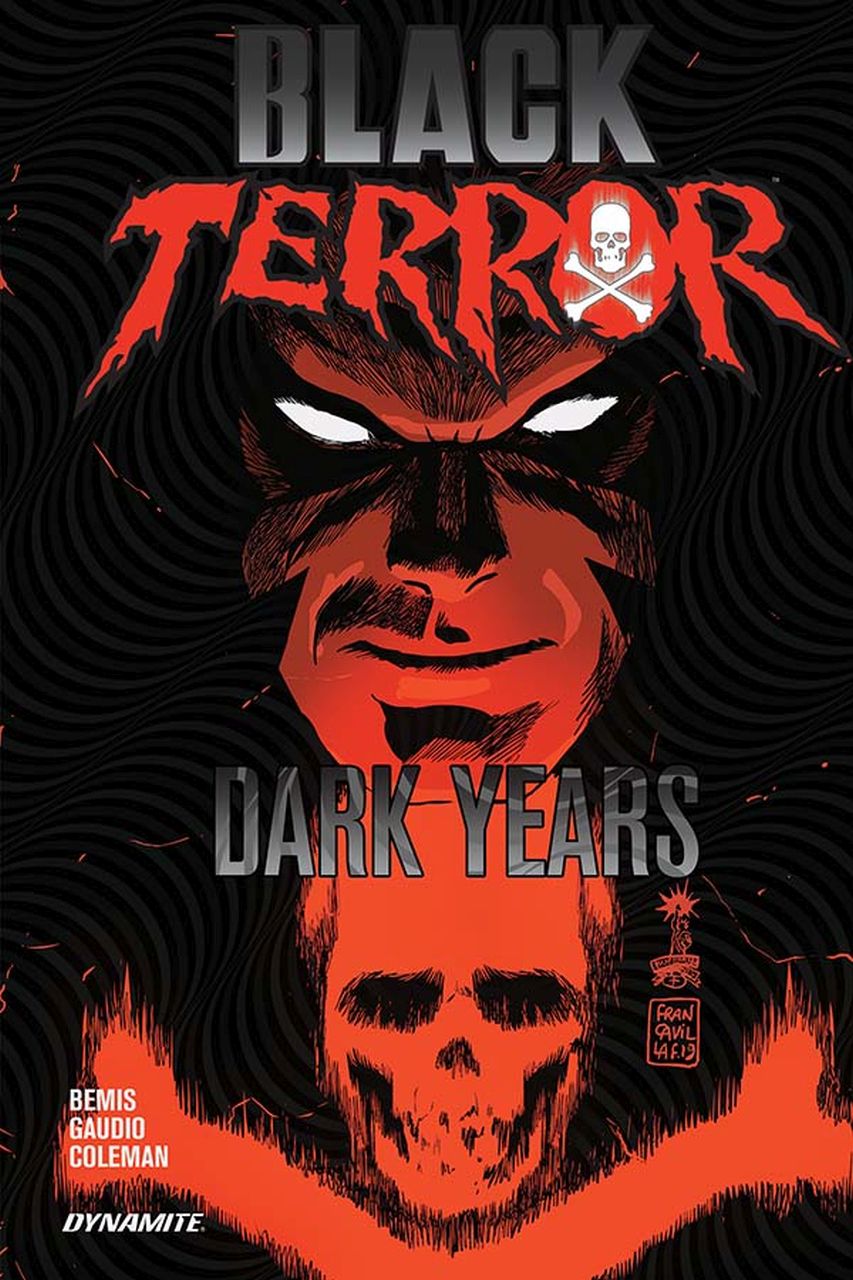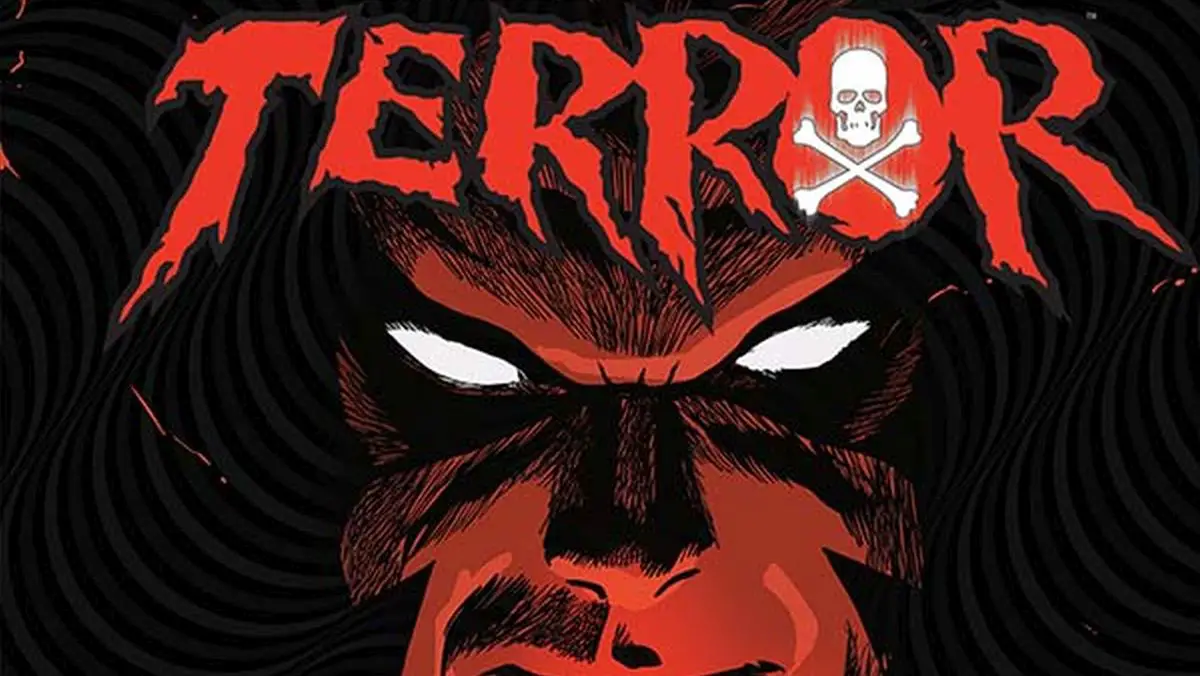In BLACK TERROR: DARK YEARS TP, available from Dynamite Comics on June 16th, 2021, Max Bemis crafts a collection of one-shots that looks at Black Terror’s life in the years after the Great Wars and Conflicts of the 20th Century have ended.
The Details
- Written By: Max Bemis
- Art By: Matt Gaudio, Ruairí Coleman
- Colors By: Brittany Pezzillo
- Letters By: Taylor Esposito
- Cover Art By: Francesco Francavilla (collection cover)
- Cover Price: $15.99
- Release Date: June 16, 2021

Was It Good?
It was depressing. Well-written and well-drawn and ultimately worth reading but depressing.
Bemis has created a collection of stories that deal with everything from PTSD to drug addiction and beyond. What does a superhero’s life become when the wars stop and all that’s left are petty criminals who would die from a single, overpowered punch? What dark places will a superhero go to when society changes to become bitter and cynical?
These are the questions Bemis asks without really showing Black terror arriving at any sort of answer. In a way, the stories ground the character in a reality that a fully-realized villain or action set piece ever could. The collection is almost a personal drama, and that makes it worth read.
The art is very good, despite changing artists from between issue 1 and issue 2. The style isn’t radically different unless you choose to be picky and the grounded (sometimes bloody) tone fits the mature nature of the story well.
You can see for yourself in our BLACK TERROR: DARK YEARS TP preview right here.
What’s It About?
[SPOILERS AHEAD – Click here if you just want the score without spoilers]
Since this is a collection of five one-shots we’ll briefly cover each, what worked, and what didn’t.
Issue #1
In Chicago 1974, Bob Benton aka Black Terror has left his costumed crimefighting behind for years. He works a 9-to-5 job as a pharmacist. However, the trauma of death and destruction still causes nightmares, and he takes Valium and other “legal” drugs to try and maintain a semblance of a normal life. Bob is barely holding it together until one day he sees a creep stealing OTC medications, and the old itch to put back on the cape kicks in.
This story is the most personally intrusive into Benton’s mentality and the dark period in his life where he struggles to reconcile the power of being a superhero with the pain his work causes. There’s nothing about this story that doesn’t work, and you get another side of superhero life that’s rarely seen.
Issue #2
An incestuous cult leader has Black Terror trapped in a cage. Through magical means, the leader can transfer Benton’s powers to all his followers, but not every attendee is bought into what the cult leader is selling.
This story is less about Black Terror and more about how the magical experience forces a new acolyte to examine how the bad experiences with her husband aren’t the result of clear, good-and-bad. Hurt people make bad choices, and simply applying superficial labels of “bad person” or “victim” becomes an easy trap to prevent healing.
This story is, again, another well-written personal drama. The one down to the issue is that Black Terror is almost incidental to the story. He’s little more than a plot device, which takes focus away from the intent of the series.
Issue #3
After the superhero team from Project: Superpowers were trapped inside Pandora’s Box and released 70+ years later, some “time anomalies” occurred. Tim Roland aka Kid Terror was reverted to a baby but his mind was left intact with all the memories of the future yet to come. He waits to for his body to age, and he waits for Bob Benton to (re)invent the formic ether that will grant him superpowers, and he waits for the world to catch up to his memories.
This story is the most humorous of the five because let’s face it, who doesn’t love a cursing baby. The humor largely comes from the contrast of modern, cynical attitudes transported back into the 40s and 50s. the story is high on the amusement factor but like the previous story, it gets a down mark because Black Terror is incidental to the plot.
Issue #4
Black Terror confronts a villain who uses experimental, psychedelic drugs. During the course of the fight, the villain kills himself rather than be captured but the super drugs from his blood splash on the Black Terror and he sees the pain and misery of a life that led Bad Groove to become a criminal. Once Black Terror sees through the criminal’s memories, what drove him to become who he is, Benton pays it forward to set things right.
Again, Benton is a plot device in this story but he has a more active role than the previous two. The more theme we see, which’s more common these days, is revealing the villain as a tragic figure who became the villain they are as a reaction to the trauma inflicted on them. It’s one of the more successful attempts at tackling the “sympathetic villain” trope, but again, we wish there was more focus on Black Terror in his own title.
Issue #5
Bob Benton visits an old flame who’s struggling with an adult son that’s a chip off the old block. Unfortunately, Benton didn’t transfer just his superpowers to his offspring, but also all his strife and struggles and trauma that goes along with it. In the end, Benton tells his son that his time of usefulness is at an end, and it’s time for a new generation to step up. Unfortunately for Benton, the transfer of the mantle happens in a way that’s more suited for something out of the animal kingdom.
Well, that’s one way to do it. The idea of passing a title or mantle isn’t a new one but this is probably the most brutal version you’re likely to see. And it’s appropriate that the capper of the collection puts a capper on Black Terror’s career…. permanently. There are some truly emotional moments in this story as father and son wrestle with an impossible situation, and while the outcome is painful and permanent, it’s somehow satisfying.
How Does It End?
It doesn’t. The legacy of the Black Terror lives on.
Final Thoughts
BLACK TERROR: DARK YEARS TP looks at the dark side of a human’s life when their superhero persona is not the star of the show. The art executes the emotional expressions perfectly and the writing goes to dark places for a unique perspective. It would have served the collection a bit better if more of the stories actually focused on the Black Terror as the main character, but the writing is strong in every issue.
Score: 8.5/10
We hope you found this article interesting. Come back for more reviews, previews, and opinions on comics, and don’t forget to follow us on social media:
If you’re interested in this creator’s works, remember to let your Local Comic Shop know to find more of their work for you. They would appreciate the call, and so would we.
Click here to find your Local Comic Shop: www.ComicShopLocator.com

